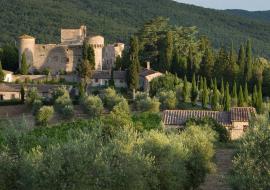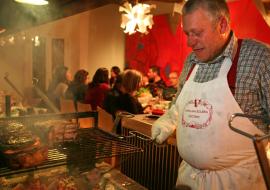Wine has been made in San Gimignano for centuries, and not just Vernaccia. In actual fact, the production of red wine has always been superior in terms of quantity to that of white. The farms of San Gimignano have always been recognised by wine traders for the quality and character of the red wines produced. Starting from this situation, in 1996 the first production regulations were drawn up with the dual intent of lending visibility and specificity to the red wines and to the Vinsanto produced in the area. The DOC created was defined as a spin-off DOC in relation to the Chianti Colli Senesi DOC, but the experimentation, research performed by the estates and the resulting wines soon highlighted the limits of these regulations, leading to radical amendments in 2003 and to a subsequent review just before the 2011 grape harvest.
Vinsanto also has a long and traditional fame in San Gimignano. In farming families, guests were always welcomed with a glass of Vinsanto, made in the "Vinsantaie" in small casks and employing techniques and procedures handed down from father to son. To lend visibility to this product and coordinate its territorial specificity, in 1996 the first production regulations were formulated along with those for San Gimignano Rosso; these were adjusted and implemented in 2003.
The human factors linked to the production territory are of fundamental importance and, thanks to consolidated tradition, they have contributed to obtaining red wines in San Gimignano: indeed the presence of viticulture in the San Gimignano area dates back to Etruscan times, with a large amount of archaeological evidence. For centuries, the production and sale of wine was the main farming and economic activity, not related exclusively to the famous Vernaccia di San Gimignano but also to red wines; in actual fact, the production of red wine has always been superior in terms of quantity to that of white.
Starting from this situation, in 1996 the first production regulations were drawn up with the intent of lending visibility and specificity to the red wines and to the Vinsanto produced in the area, updating the vinification techniques and introducing the use of other red grape varieties to complement Sangiovese. This brings us up to the present-day situation, described by the production regulations currently in force, which are the product of tradition and innovation, focusing on making wines of better and better quality.
CHARACTERISTICS
The San Gimignano appellation allows the production of nine different types of wine. Of these, six are red wines (some of which bear the mention “riserva”), one is a rosé and two are Vinsanto, which, from the analytical and organoleptic viewpoint, present very evident and specific characteristics which are described in article 6 of the regulations, which allow clear identification linked to the geographic context.
“Rosso” is made with a minimum of 50% Sangiovese, up to a maximum 40% of Cabernet Sauvignon, Merlot, Syrah or Pinot Nero, either alone or in combination, and up to a maximum 15% of other non-aromatic red grape varieties suitable for cultivation in Tuscany.
In addition to Rosso it is possible to make five other types of wine with the indication of the following grape varieties: Sangiovese, Cabernet Sauvignon, Merlot, Syrah and Pinot Nero. To be able to indicate these types on the label, the wines must contain a minimum 85% of the grape variety used.
Rosato (rosé) must be made with the same grape varieties as Rosso: a minimum of 50% Sangiovese, up to a maximum 40% of Cabernet Sauvignon, Merlot, Syrah or Pinot Nero, either alone or in combination, and up to a maximum 15% of other non-aromatic red grape varieties suitable for cultivation in Tuscany.
As regards the red wines, these are distinguished by a more or less intense ruby red colour, tending towards garnet with age; the rosé wines must have a more or less bright pink colour; the colour of San Gimignano Vinsanto spans from bright yellow to gold, while that of San Gimignano Vinsanto Occhio di Pernice goes from deep pink to pale pink. At olfactory level, delicate, intense and varietal aromas are present depending on the type of wine. All the wines taste dry and harmonious, while the various types of Vinsanto are smooth and velvety.
The grape varieties used for both red wine and Vinsanto and the vinification techniques have always been the same used throughout most of the Tuscan hills; however, the particular soil and microclimate of San Gimignano allow the production of grapes with different specific characteristics to those grown in the neighbouring areas. These characteristics, such as the phenolic component for red wine and savouriness, are then transmitted to the wines, making them unique and recognisable in the panorama of Tuscan wines. The different percentage combination between sand, clay, organic substance and heavy stone that characterises each type of soil is the determinant pedagogical element from the winegrowing-oenological point of view in order to enhance the savouriness and capacity for ageing, characteristics which are shared by the different types of San Gimignano DOC.
The winemaking methods are those traditionally consolidated in the area for vinification of red and rosé wines and Vinsanto, correctly differentiated by type. This is why the farms of San Gimignano have always been recognised by wine traders for the quality and character of the wines produced, evolving more and more, so much so that, in the 20th century, the spirit of research of the winegrowers gave life to a series of experiments which led to the stable cultivation on the hills of San Gimignano of international red grape varieties such as Merlot, Cabernet, Syrah and Pinot Nero, as well as expanding traditional vinification techniques with the use of wooden containers in different sizes.
PAIRINGS AND SERVING TEMPERATURE
San Gimignano’s wine is adapted to being paired with multiple national and international dishes. The different Red and Red Sangiovese, Merlot, Cabernet, Syrah and Pinot Noir, match with meats, cheeses, dishes with structured sauces and red meat also made with mushrooms and truffles. As regards the Rosato the matching is with first courses with harmonic flavors and with medium structure. Also excellent with many fish dishes. With regard to the service temperature, the Rosato type must be served at 10° - 12° C while, vinsanto and all kinds of red, must be served at 18 - 20° C.


| << | December 2025 | >> | ||||
| Sun | Mon | Tue | Wed | Thu | Fri | Sat |
| 1 | 2 | 3 | 4 | 5 | 6 | |
| 7 | 8 | 9 | 10 | 11 | 12 | 13 |
| 14 | 15 | 16 | 17 | 18 | 19 | 20 |
| 21 | 22 | 23 | 24 | 25 | 26 | 27 |
| 28 | 29 | 30 | 31 | |||